






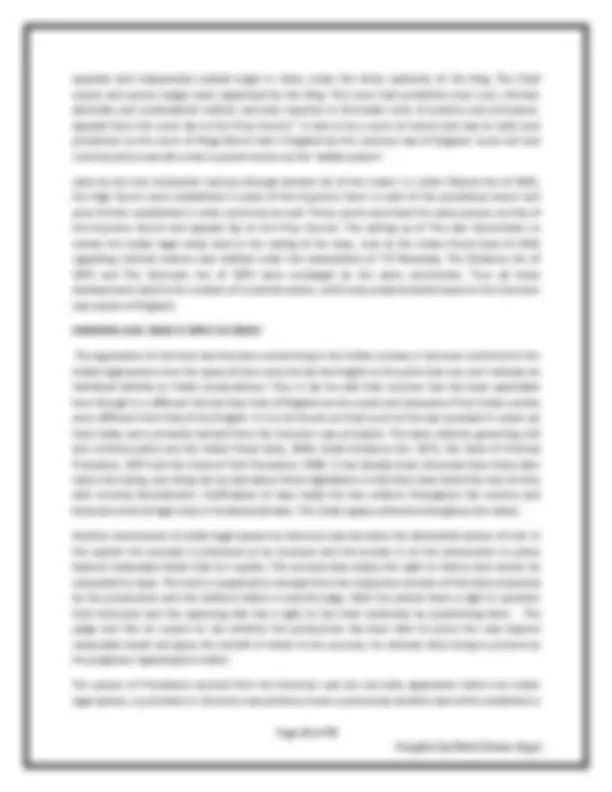

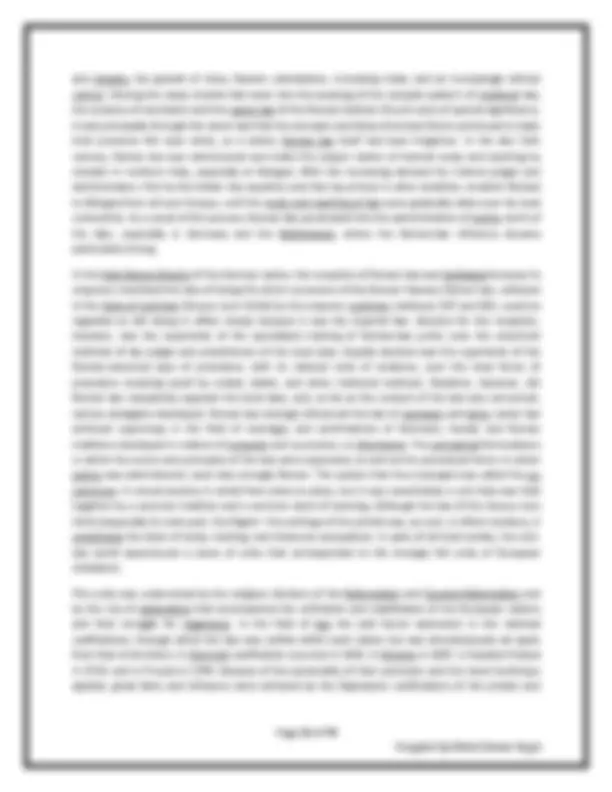
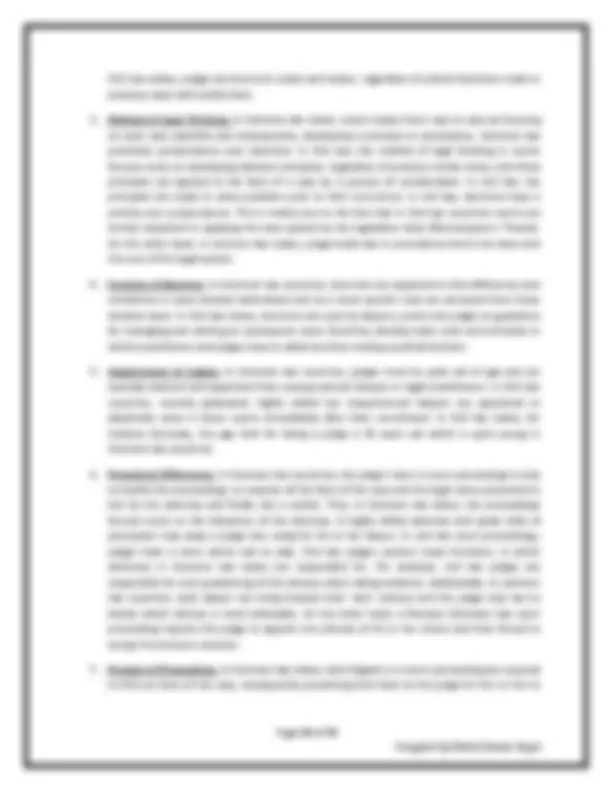










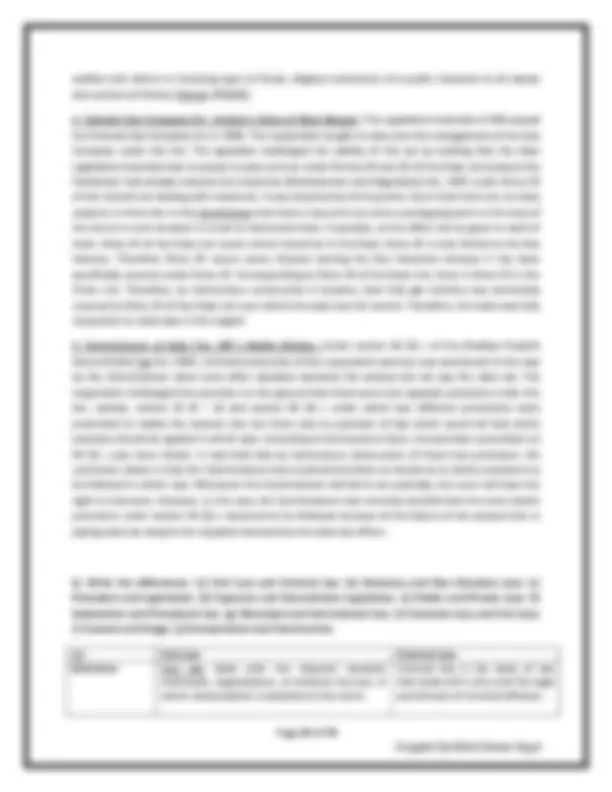







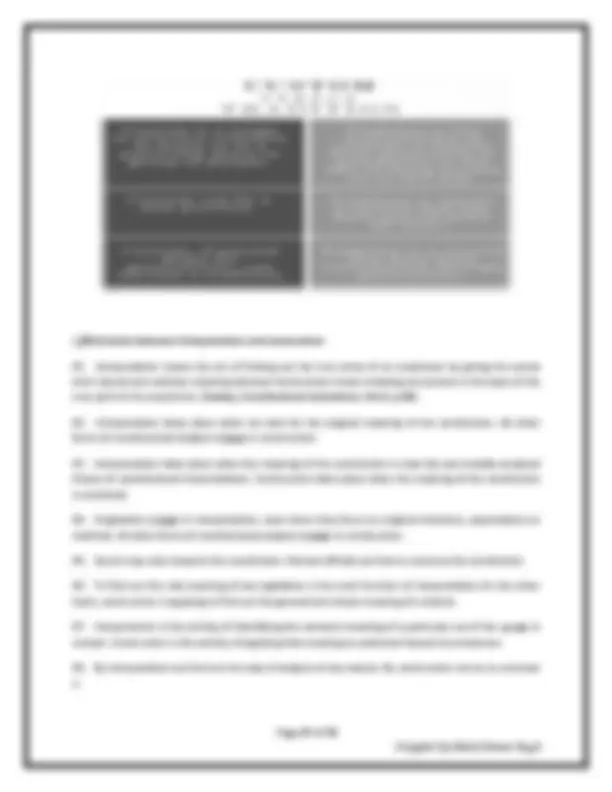





























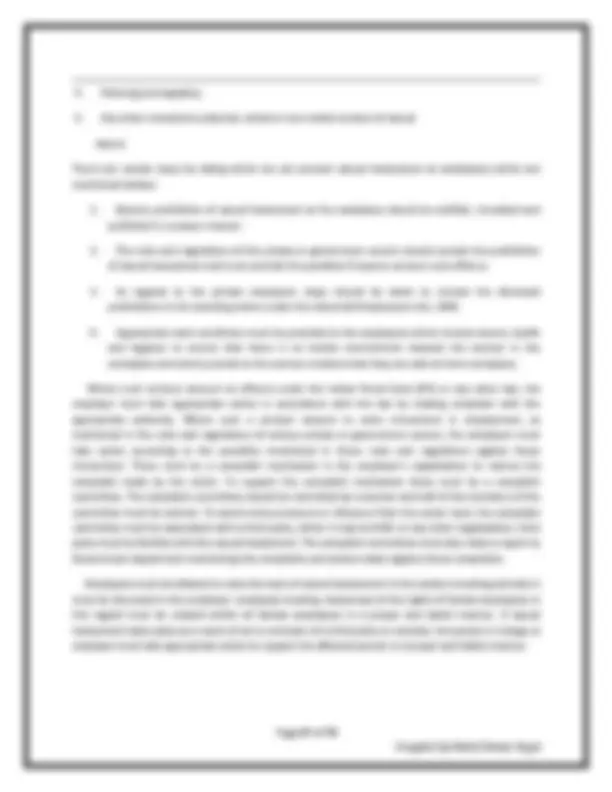





Study with the several resources on Docsity

Earn points by helping other students or get them with a premium plan


Prepare for your exams
Study with the several resources on Docsity

Earn points to download
Earn points by helping other students or get them with a premium plan
Community
Ask the community for help and clear up your study doubts
Discover the best universities in your country according to Docsity users
Free resources
Download our free guides on studying techniques, anxiety management strategies, and thesis advice from Docsity tutors
IT'S IMPOORTANCE & SYLLABUS FOR 3RD SEM
Typology: Lecture notes
1 / 70

This page cannot be seen from the preview
Don't miss anything!































































Page 1 of 70
Q. What are the basic sources of law?
1. Custom: Custom has been one of the oldest sources of law. In ancient times, social relations gave rise to several usages, traditions and customs. These were used to settle and decide disputes among the people. Customs were practiced habitually and violations of customs were disapproved and punished by the society. Initially social institutions began working on the basis of several accepted customs.
Gradually, the State emerged as the organised political institution of the people having the responsibility to maintain peace, law and order; naturally, it also began acting by making and enforcing rules based upon customs and traditions. In fact, most of the laws had their birth when the State began converting the customs into authoritative and binding rules. Custom has been indeed a rich source of Law.
2. Religion and Morality: Religion and religious codes appeared naturally in every society when human beings began observing, enjoying and fearing natural forces. These were accepted as superior heavenly forces (Gods and Goddesses) and worshiped.
Religion then started regulating the behaviour of people and began invoking “Godly sanction”, “fear of hell”, and “possible fruits of heaven”, for enforcing the religious codes. It compelled the people to accept and obey religious codes. Several religions came forward to formulate and prescribe definite codes of conduct. The rules of morality also appeared in society. These defined what was good & what was bad, what was right and what was wrong.
The religious and moral codes of a society provided to the State the necessary material for regulating the actions of the people. The State converted several moral and religious rules into its laws. Hence Religion and Morality have also been important sources of Law.
3. Legislation: Since the emergence of legislatures in 13th century, legislation has emerged as the chief source of Law. Traditionally, the State depended upon customs and the decrees or orders of the King for regulating the behaviour of the people. Later on, the legislature emerged as an organ of the government. It began transforming the customary rules of behaviour into definite and enacted rules of behaviour of the people.
The King, as the sovereign, started giving these his approval. Soon legislation emerged as the chief source of law and the legislature got recognition as the Legal Sovereign i.e. law-making organ of the State. In contemporary times, legislation has come to be the most potent, prolific and direct source of law. It has come to be recognized as the chief means for the formulation of the will of the State into binding rules.
4. Delegated Legislation: Because of several pressing reasons like paucity of time, lack of expertise and increased demand for law-making, the legislature of a State finds it essential to delegate some of its law- making powers to the executive. The executive then makes laws/rules under this system. It is known as
Page 2 of 70
Delegated Legislation. Currently, Delegated Legislation has come to be a big source of Law. However, Delegated Legislation always works under the superior law-making power of the Legislature.
5. Judicial Decisions: In contemporary times, Judicial Decision has come to be an important source of Law. It is the responsibility of the courts to interpret and apply laws to specific cases. The courts settle the disputes of the people in cases that come before them. The decisions of the courts – the judicial decisions, are binding on the parties to the case. These also get accepted as laws for future cases. But not all judicial decisions are laws.
Only the judicial decisions given by the apex court or the courts which stand recognized as the Courts of Record, (like the Supreme Court and High Courts of India) are recognized and used as laws proper. Lower Courts can settle their cases on the basis of such judicial decisions.
5. Equity: Equity means fairness and sense of justice. It is also a source of Law. For deciding cases, the judges interpret and apply laws to the specific cases. But laws cannot fully fit in each case and these can be silent in some respects. In all such cases, the judges depend on equity and act in accordance with their sense of fair play and justice. Equity is used to provide relief to the aggrieved parties and such decisions perform the function of laying down rules for the future. As such equity acts as a source of law. 6. Scientific Commentaries: The works of eminent jurists always include scientific commentaries on the Constitution and the laws of each state. These are used by the courts for determining the meaning of law. It helps the courts to interpret and apply laws.
The jurists not only discuss and explain the existing law but also suggest the future possible rules of behaviour. They also highlight the weaknesses of the existing laws as well as the ways to overcome these. Interpretations given by them help the judges to interpret and apply Laws to specific cases.
The works of jurists like, Blackstone, Dicey, Wade, Phillips, Seeravai, B.Pi. Rau, D.D. Basu and others have been always held in high esteem by the judges in India. Scientific commentaries jurists always help the development and evolution of law. Hence these also constitute a source of law. Thus, Law has several sources. However, in contemporary times law-making by the legislature constitutes the chief source of Law.
Q. Discuss legislation, precedent and custom as a source of law.
Legislation - ‘Legis’ means law and ‘latum’ means making. Let us understand how various jurists have defined legislation.
Page 4 of 70
It is advisable that in matters of technical nature, opinion of experts must be taken. It will definitely minimize the dangers of enacting a vague legislation.
Precedent as a Source of Law
In India, the judgment rendered by Supreme Court is binding on all the subordinate courts, High Courts and the tribunals within the territory of the country.
In case of a judgment rendered by the High Court, it is binding in nature to the subordinate courts and the tribunals within its jurisdiction.
In other territories, a High Court judgment only has a persuasive value. In Indo-Swiss Time Ltd. v. Umroo, AIR 1981 P&H 213 Full Bench , it was held that “where it is of matching authority, then the weight should be given on the basis of rational and logical reasoning and we should not bind ourselves to the mere fortuitous circumstances of time and death”.
Union of India v. K.S. Subramanium- AIR 1976 SC 2435 - This case held that when there is an inconsistency in decision between the benches of the same court, the decision of the larger bench should be followed.
What is the meaning of Precedent as a source of law?
Till the 19th^ Century, Reported Court Precedents were probably followed by the courts. However, after 19 th^ century, courts started to believe that precedence not only has great authority but must be followed in certain circumstances. William Searle Holdsworth supported the pre-19th^ century meaning of the precedence. However, Goodheart supported the post-19th^ century meaning.
Declaratory Theory of Precedence - This theory holds that judges do not create or change the law, but they ‘declare’ what the law has always been. This theory believes that the Principles of Equity have their origin in either customs or legislation. However, critics of this theory say that most of the Principles of Equity have been made by the judges and hence, declaratory theory fails to take this factor into regard.
Types of Precedents
Page 5 of 70
Disregarding a Precedent - Overruling is a way by which the courts disregard a precedent. There are circumstances that destroy the binding force of the precedent:
Custom is a habitual course of conduct observed uniformly and voluntarily by the people concerned. When people fine any act to be good and beneficial, which is agreeable to their disposition, they practice it and in course of time by frequent observance and on account of its approval and acceptance by the community for generations, a custom evolves. In all societies of the world, custom has enjoyed a very high place in varying degree in the regulation of human conduct. Customs arise whenever a few human beings come permanently without adopting consciously or unconsciously, some definite rules governing reciprocal rights and obligations. Custom is to society what law is to the state. Contents.
In primitive societies human conduct was regulated by practices which grew up spontaneously and were later adopted by the people. What was accepted by the generality of the people and embodied in their customs was deemed to be right. So, custom has played an extremely significant role as a source of law, till other sources of law like legislation and precedent acquire prominence. Customs have been the most potent force in molding the ancient law.
Acceptance of customs as a source of law: Salmond has pointed out two reasons for the recognition of customs as a source of law. Firstly, custom is frequently the embodiment of those principles which have commanded themselves to the national conscience as principles of justice and public utility. Secondly, the existence of an established usage is the basis of a rational expectation of its continuance in the future. Salmond adds, ‘’justice demands that, unless there is good reason to the contrary , men’s rational expectations shall, so far as possible, be fulfilled rather than frustrated.
Page 7 of 70
Conventional custom A conventional custom is one whose authority is conditional on its acceptance and incorporation in the agreement between the parties to be bound by it. A conventional custom is an established practice, which is legally binding because it had been expressly or impliedly incorporated in a contract between the parties concerned. Views of analytical school in regard to custom as a law The great advocates of the analytical theory are Austin, Holland, Gray, Allen and Vinogradoff. According to Austin one of the main priests of analytical school, custom is a source of law and not law in itself. Custom are not positive laws until their existence is recognized by the decisions of the courts. A custom becomes law when it is enforced by the state. It is not every custom that is binding. Only those customs are valid which satisfy the judicial test. The sovereign can abolish a custom. A custom is law only because the sovereign allows it to be so.
According to Austin, a custom is a rule of conduct which the governed observe spontaneously and not in pursuance of law settled by a political superior. Austin’s view is based on two propositions-the first preposition is that it is not every custom that is binding but only those which are valid-the validity being determined by judicial recognition. A custom when so recognized are only social customs or merely rules of positive morality. The second proposition is that a sovereign or a legislature very often abolishes customs and is, therefore, superior to them. A custom is law only because a sovereign allows it to be so.
According to Holland , customs are not laws when they arise but they are largely adopted into laws by state recognition the existence of a custom. English courts require that not only the existence of a custom be proved but it should also be proved that the same is reasonable. The legislature can also abrogate customs whether partially or wholly. To quote Holland, “Binding authority has thus been conceded to custom, provided it fulfils certain requirements the nature of which has also long since been settled and provided it is not superseded by law of a higher authority. When, therefore, a given set of circumstances is brought into court and the court decides upon them by bringing then within the operation of a custom, the court appeals to that custom as it might to any other pre-existent law. It does not proprio motu then for the first time make the custom a law; it merely decides as a fact that there exists a legal custom about which there might up to that moment have been some questions, as there might about the interpretation of an Act of Parliament.”
As per the historical school of jurisprudence, law is essentially the product of normal forces associated with the spirit of each particular people and nothing is more representative of these revolutionary processes than the autonomous customs which are found to exist in each community, and which are indigenous as its flora or fauna. Custom carries its own justification in itself because it would not exist at all unless some deep seated need of the people or some quality of temperament gave rise to. Essentials of a valid legal custom Certain tests or essentials have been laid down by the jurists which a custom must satisfy for its judicial recognition.
Essentials of a valid custom are:
Antiquity : A custom to be recognized as law must be proved to be in existence from time immemorial.
Continuity: It must have been practiced continuously. If a custom is disturbed for a considerable time, a presumption arises against it.
Page 8 of 70
Reasonableness : A custom must be reasonable. For declaring a custom inapplicable on the ground of unreasonableness, it will have to be shown that it is obviously opposed to reason. Conformity with statute law : A custom, to be valid, must be in conformity with statute law. It is a positive rule in most of the legal systems that a statute can abrogate a custom.
Consistency: Custom must not come into conflict with the other established customs. There must be set in opposition to the other custom.
Q. Define law according to various jurists. what are the purpose and functions of law?
The word ‘Law’ has been derived from the Teutonic word ‘Lag, which means ‘definite’. On this basis Law can be defined as a definite rule of conduct and human relations. It also means a uniform rule of conduct which is applicable equally to all the people of the State. Law prescribes and regulates general conditions of human activity in the state.
John Austin (English jurist born 1790): "A rule laid down for the guidance of an intelligent being by an intelligent being having power over him."
Professor Hart: Hart defined law as a system of rules, a union of primary and secondary rules,
Marxist theory : Marxist theories of law generally define law as a tool of oppression used by capitalists to control the proletariat.
Plato : “An embodiment of Reason”, whether in the individual or the community’.
St Thomas Aquinas: "Nothing else than an ordinance of reason for the common good, made by him who has care of the community, and promulgated"
Oliver Wendell Holmes :"The prophecies of what the courts will do ... are what I mean by the law,"
Karl Llewellyn : "What officials do about disputes,"
Lord Browne-Wilkinson: "‘The sum of the influences that determine decisions in courts of justice."
Max Weber : "Law…exist if it is externally guaranteed by the probability of coercion (physical or psychological) to bring about conformity or avenge violation, and is applied by a staff of people holding themselves specially ready for that purpose."
Thomas Hobbes: Hobbes said of the role and function of law in his polemic work
Leviathan’ (1651) : "Law is the formal glue that holds fundamentally disorganised societies together."
Glanville Williams : “Learning the law” "Law is the cement of society and also an essential medium of change. Knowledge of law increases one’s understanding of public affairs. Its study promotes accuracy
Page 10 of 70
Having examined the various definitions of writers that formed several schools of thoughts as to the meaning of law and also a brief understanding of the role of law in the society, this work concludes on the notion that the law is living, organic, dynamic and remains a tool for social engineering.
The purpose of law is to produce either of two things: (a) an idealistic society or (b) a practical society more tolerable than what has been labeled by some philosophers as the state
The Function of Law
Q. Discuss the common law System and Romano Germanic systems of law and point out the differences between the above two legal systems. Does Common Law apply in India?
“Our lady the Common Law is a very wise old lady though she still has something to learn in telling what she knows”. – FREDERICK POLLOCK
The common law, as aptly put by the fabled English jurist Sir Frederick Pollock resounds of the comprehensive nature of law. This quintessentially universal and sentient law, since its inception has acted as the derivative of human conduct, used to maintain order where there was none. But what is common law? It refers to the unwritten, judge made law as opposed to written law (statutory law). Common law was developed by judges through the decisions of the courts. A common law system was first developed in England from where, with the aggressive expansion of the English empire this system of law too traversed to different parts of the world, of which India became one of its destinations.
COMMON LAW: DEFINITION AND ORIGINS
The Common Law is a body of law derived from judicial decisions known as case laws, rather than from statutes. The Common Law derived its authority from the universal consent and practice of the people
Page 11 of 70
from time immemorial. This system of jurisprudence initially originated in England. Common Law is unintelligible until expressed in a judgment. It includes those rules of law which derive their authority from the statement of principles found in the decisions of courts. This system of law includes tradition, custom and usage, fundamental principles and modes of reasoning. It is the embodiment of broad and comprehensive unwritten principles, which were derived out of natural reasoning and innate sense of justice.
A Common Law system requires several stages of research and analysis to determine the appropriate law in a given situation. The facts are ascertained properly, relevant cases and statutes are to be identified, and the principle, ideas by various courts need to be understood and applied in order to determine how they would help in understanding the point of law in question within that case. The common law is quite different from codified law as it follows the judgment while the codified law precedes it. Therefore it can be said that it is a system of rules and declarations of principles from where the judicial ideas and legal definitions are derived. This law is ever changing as its principles are influenced by the changing conditions and requirements of the society.
The origin of the common law system can be traced back to England, where after the Norman conquest (1066 A.D.). The new ruler of England William II brought about a varied number of governmental reforms, as a consequence he also overhauled the legal setup of England. Earlier the legal system of England comprised of county courts presided by the bishop and the county sheriffs, who exercised both criminal and civil jurisdiction. William II introduced the system of Eyre, wherein four judges were appointed by the King, their main function was to review the activities of the county courts and hear cases of appeals. It was used as a tool to centralize control over local courts, thus it provided a basis for the development of common law in England.
The dawn of this system came with Henry II ascendance to power. He is considered the harbinger of a common law system as he created a system of law, common to the whole of England. Some of the features of this system were; firstly a practice developed of sending judges from his own court i.e. a central court established at Westminster, to places around the country for deciding cases in the local courts. These cases were decided with the help of local customs. Secondly, these cases were recorded and filed at the permanent court in Westminster, with the due passage of time these decided cases began to be referred in other cases having similar facts. This principle of law came to be known as precedents. Thirdly, local customs became the primary source of law as they were used in trials to decide points of law. A system of jury was also developed where citizens decided matters of law based on common law knowledge and local customs. Hence the culmination of a centralized system of law with the practice of keeping record of decided cases for future reference wherein customs also played an exemplary role to decide nuanced points of law together gave birth to what is referred to as “The common law”.
Common law has no basis in statute, and is established and developed through written opinions of judges delivered at the end of a trial. These opinions are binding on future decisions of lower courts in the same jurisdiction. However, that is not to say that common law systems derive all of their laws from case law. Democratic countries that have adopted the common law system have legislative bodies at
Page 13 of 70
separate and independent judicial organ in India, under the direct authority of the King. The Chief Justice and puisne Judges were appointed by the King. This court had jurisdiction over civil, criminal, admiralty and ecclesiastical matters and was required to formulate rules of practice and procedure. Appeals from this court lay to the Privy Council.” It was to be a court of record and was to hold such jurisdiction as the court of Kings Bench had in England by the common law of England. Local civil and criminal justice was left under a system known as the “adalat system”.
Later by the mid nineteenth century through another act of the crown i.e. Letter Patents Act of 1862, the High Courts were established in place of the Supreme Court in each of the presidency towns and were further established in other provinces as well. These courts exercised the same powers as that of the Supreme Courts and appeals lay to the Privy Council. The setting up of The Law Commission to review the Indian legal setup lead to the coding of the laws, such as the Indian Penal Code of 1862 regarding criminal matters was drafted under the stewardship of T.B Macaulay. The Evidence Act of 1872 and The Contracts Act of 1872 were envisaged by the same commission. Thus all these developments lead to the creation of a judicial system, which was predominantly based on the Common Law system of England.
COMMON LAW: DOES IT APPLY IN INDIA?
The application of common law has been overarching in the Indian context; it has been enshrined in the Indian legal system over the space of two centuries by the English to the point that one can’t allocate an individual identity to Indian jurisprudence. Thus it can be said that common law has been applicable here though in a different format than that of England as the needs and demands of the Indian society were different from that of the English. It is to be found out that much of the law compiled in codes we have today were primarily derived from the Common Law principles. The basic statutes governing civil and criminal justice are the Indian Penal Code, 1860, Indian Evidence Act, 1872, the Code of Criminal Procedure, 1973 and the Code of Civil Procedure, 1908. It has already been discussed how these laws came into being, one thing can be said about these legislations is that they have stood the test of time with minimal amendments. Codification of laws made the law uniform throughout the country and fostered a kind of legal unity in fundamental laws. The Codes apply uniformly throughout the nation.
Another contribution to Indian legal system by Common Law has been the adversarial system of trial. In this system the accused is presumed to be innocent and the burden is on the prosecution to prove beyond reasonable doubt that he is guilty. The accused also enjoys the right to silence and cannot be compelled to reply. The truth is supposed to emerge from the respective versions of the facts presented by the prosecution and the defence before a neutral judge. Both the parties have a right to question their witnesses and the opposing side has a right to test their testimony by questioning them.. The judge acts like an umpire to see whether the prosecution has been able to prove the case beyond reasonable doubt and gives the benefit of doubt to the accused, his ultimate duty being to pronounce the judgment regarding the matter.
The system of Precedents derived from the Common Law too has wide application within the Indian legal system, a precedent in Common Law parlance means a previously decided case which establishes a
Page 14 of 70
rule or principle that may be utilized by the court or a judicial body in deciding other cases that are similar in facts or issue. Initially the English judges and barristers presiding and practicing in the Indian courts followed the decisions of the courts in England, thus slowly the concept of precedents came to be ardently followed within the Indian courts. This law has been carried forward in the present day Legal system as in regard to the judgments of the Supreme Court of India the Indian Constitution provides that “The law declared by the Supreme Court shall be binding on all courts within the territory of India.” Hence it can be said unequivocally that Common Law has wide application within the Indian Legal fold as many of the features of this system have been adopted and further developed from that of The English Common Law System, even though its application hasn’t been discussed in entirety and only the major principles derived from it have been discussed.
Thus it can be said that common law traces back its origins to England and is primarily a method of administering justice, which has incorporated different aspects of the legal pedagogy and practice with the help of deliberations of laymen and the learned over the course of time. In the Indian context the common law initially was applied for the convenience of the English, so they could govern their territories properly but, as they became the overlords of India the common law became common for Indians. There developed a symbiotic relationship between the Indian customary law and the common law which gave birth to the modern day Indian legal system. Hence we can say India has an organic law as a consequence of the common law system
Civil law, also called Romano-Germanic law, the law of continental Europe, based on an admixture of Roman, Germanic, ecclesiastical, feudal, commercial, and customary law. European civil law has been adopted in much of Latin America as well as in parts of Asia and Africa and is to be distinguished from the common law of the Anglo-American countries.
The term civil law has other meanings not employed in this article. The term jus civile , meaning “civil law,” for example, was used in ancient Rome to distinguish the law found exclusively in the city of Rome from the jus gentium , the law of all nations, found throughout the empire. The phrase has also been used to distinguish private law, governing the relations between individuals, from public law and criminal law. Finally, in the philosophy of law, civil law sometimes refers to the positive law of the state, as distinct from natural law.
The historical rise of civil law
In the 5th and 6th centuries CE, western and central Europe were dominated by Germanic peoples, especially those who had overrun the Roman Empire. Among them were the Anglo-Saxons of England, the Franks of western Germany and northern France, the Burgundians, the Visigoths of southern France and Spain, and the Lombards of Italy. Although the traditions of Roman law endured for some time, Germanic customs came to prevail in most regions. In the Middle Ages these customs underwent vigorous growth in an effort to satisfy the complex needs stemming from the development of feudalism
Page 16 of 70
criminal law of France, especially their central piece, the civil code of 1804 that came to be known as the Napoleonic Code.
Codification continued after the Napoleonic era. In Belgium and Luxembourg, which had been incorporated into France under Napoleon, his codes were simply left in effect. The Netherlands, Italy, Spain, Portugal, and numerous countries of Latin America followed the French model not only by undertaking national codification but also by using the same techniques and arrangements. Naturally, their courts and legal scholars were, at least in the early 19th century, inclined to pay great attention to French legal learning.
In Germany national codification came considerably later than in France. Only a commercial code had been uniformly created by the independent German states shortly after the revolution of 1848. The unification of the criminal law took place almost simultaneously with the political unification of the country, which occurred in 1871. Codification of the organization of the courts and of civil and criminal procedure came in 1879. But the German Civil Code (Bürgerliches Gesetzbuch für das deutsche Reich) was not completed until 1896, and it did not take effect until Jan. 1, 1900.
Throughout the 19th century the vigorous German science of law exercised much influence in Austria (which as early as 1811 had codified its law in a technique different from that of France), in Switzerland, in the Nordic countries, and, later, in most of eastern Europe. When Swiss law was codified in 1907–12, it became the model for the Turkish codification of 1926 and strongly influenced the codification of China, which is still in effect in Taiwan.
Owing to the different dates of codification and the different style and attitude of legal learning, the civil-law family of laws is thus divided into the French, or Romanist, branch and the German, or Germanic, branch. Their main features are determined by those of their prototypes. The legal system of Japan essentially belongs to the German branch, but it presents important features of its own.
FEATURES
Main feature of this legal family is its formation on the basis Roman law. Decisive role in shaping her belonged to medieval universities in Europe, where it was delivered to the study of Roman and canon law, and later began to develop and national law. The date of foundation Romano-Germanic legal family are considered to be 12-13 century. Bologna University in Italy has been alma mater of common law universities - Romano -Germanic legal system. As part of the Western university science right studied in its relationship with religion, philosophy, theology. Study Roman legal culture, the codification of Emperor Justinian, the rapid growth the authority of Roman law, the so-called "Reception of Roman law" had place in conditions of rapid economic development, growth, trade and cities. The study of Roman law, the process of becoming itself a legal science inspired by political events of the time, especially struggle between secular and ecclesiastical authorities, the growth of bureaucratic power structures.
In each European country forming a national legal system was based on the study of Roman law and united with the record customary law of the country in clear and precise terms, the organization of
Page 17 of 70
these customary law in a system. For the Romano-Germanic legal system perspective of the right in its relationship with morality as requirement should be, the optimal generalized rule of law, separation of law for public and private, the allocation of the various branches of law. In this family very fully developed civil law, as reflected in science civil law. Legal system Roman-Germanic family are well developed legislation. If long-term basic source of law in this family was the doctrine, in the modern era recognizes the rule of law, among other sources of law. In states that legal family is the fundamental law of the constitution systematization of legislation is carried out, there are codes. Forms state-legal acts are the decrees, regulations, administrative circulars and others.
In the Romano-Germanic legal family law and the right not to be identified. It circumstance is reflected in the interpretation of the law, which provides courts. Limited role among the sources of law now belongs to the tradition, which was of great importance in the development of Romano -Germanic legal family.
For the Roman-Germanic legal family is characterized by a developed legal system, within a framework recognizes the importance of judicial practice in as a source of law. R. David at work "The main legal systems modernity "notes that in Germany and France, the jurisprudence in some areas played a leading role in the development of law and where doctrinal works in some cases are nothing more than a statement of judicial practice.
Of course, the importance of jurisprudence among the sources of law in the Romano -Germanic legal family is very different from English common law. Doctrine, general principles of law have meaning in as sources of law in the Romano-Germanic system. Practice ships of these countries shows that the doctrine and general principles used in interpreting and applying laws. In legal understanding are expression of an idea and sense of justice, the idea of the combination, compromise various interests, including private and state interests, society.
Difference between Common Law & Romano Germanic Law (Civil Law)
Common Law is a legal tradition that originated in England from the 11th^ Century onwards. Civil or Romano Germanic Law developed mainly in Continental Europe. There are a number of distinctive features that distinguishes Common Law from Romano Germanic Law.
Page 19 of 70
make a verdict. In Civil law proceedings, the purpose is simply to settle disputes. This is one of the reasons why lawyers in Civil law litigation have an inadequate role when litigating.
In conclusion, the administration of justice in Romano Germanic law focuses more on codified, abstract principles in which judges have to abide when making a judicial decision. The codes in civil law states are concise, amorphous and are made to solve problems even before the appearance of the problems. On the other hand, Common law focuses more on judicial precedence, where each case is examined on its own and as a result a principle is formed. Consequently, these principles are harnessed by judges to adjudicate on cases that come before them.
Q. Explain briefly African and Primitive System of Law.
Introduction: Legal pluralism is a key feature of African legal systems. The form of pluralism that permeates these systems derives from what is known as the principle of "legal centrism," which holds that all law emanates from the state and that rites developed and practiced by non state actors, including religious and customary institutions, are law only to the extent they are recognized by the state. This may occur through "normative recognition" in which state institutions recognize substantive customary and/or religious laws as law, and/or through "institutional recognition" in which the actions of customary institutions are considered enforceable.
This form of legal pluralism, the origins of which are traced to 1772 British India, arrived in Africa with European colonialism. Prior to that, customary laws governed all affairs of the people of Africa. Customary laws are local in nature and jurisdiction over such laws and the institutions that administer them were historically ascertained on the basis of membership in a group. This meant that the affairs of the over eight hundred ethnic or linguistic groups on the continent were governed by an equal number of different customary rites. With the arrival of the Europeans, various groups were combined within territories formed along arbitrary lines and subjected to laws and institutions that operated along the lines of these newly created territories. Although not completely eliminated, the reach of customary laws and institutions was greatly diminished as their application was relegated to instances where the formal, state-sanctioned laws allowed.
This gave rise to laws defining the occasions and manner in which customary laws would be applied. For instance, in Nigeria, this was first done through the Supreme Court Ordinance of 1876 of the Colony of Lagos. This law did two things: (1) it addressed the standard problems that resulted from having more than one law applying in a given jurisdiction; and (2) it defined the parties and subject matter that would be governed by customary laws. Significantly, it introduced a test (widely known as the repugnancy test) for the application of customary law, which provides as follows:
Nothing in this Ordinance shall deprive the Supreme Court of the right to observe and enforce the observance, or shall deprive any person of the benefit, of any law or custom existing in the said Colony and Territories subject to its jurisdiction, such law or custom not being repugnant to natural justice, equity and good consciousness, nor incompatible either directly or by necessary implication with any
Page 20 of 70
enactment of the Colonial Legislature existing at the commencement of this Ordinance, or which may afterwards come into operation.
After independence, African countries by and large continued the limitations imposed on the application of customary laws. For instance the Judicature Act of Kenya, the law governing the application of customary laws, states, the High Court, the Court of Appeal and all subordinate courts shall be guided by African customary law in civil cases in which one or more of the parties is subject to it or affected by it, so far as it is applicable and is not repugnant to justice and morality or inconsistent with any written law Nigeria's Federal Evidence Act and Supreme Court Act, as well as state laws, impose similar limitations.
Although their application is limited, customary laws and institutions continue to play a significant role in the lives of large segments of the population in African countries. This is because the limited subject matter areas they govern (including matters of personal status, property, and traditional authority) are those that impact greatly the day-to-day lives of the people. Significantly, for large segments of the African population, especially in rural areas, customary laws and institutions are the only available means of conflict resolution.
Application of Customary Law: Nigerian Example
Today, the application of customary law by courts in pluralist jurisdictions presents at least two issues. One involves the question of how to establish a particular customary law. This is mainly because (unlike state law, which tends to be uniform, relatively stable, and is issued formally and publicized) customary law in African jurisdictions is diverse and "remains largely unwritten, informal, and often difficult to ascertain." Thus, while these characteristics do not impede its use or effectiveness in the immediate area where it is routinely practiced, its application in remote locations or formal courts requires a procedure for its ascertainment.
African countries have adopted different methods of ascertainment. For instance, if a customary law is invoked in civil proceedings before Nigerian courts (except in certain Sharia and area/customary courts), it may be ascertained in one of two ways: (1) through judicial notice (this occurs when the particular custom in question has been established in a superior court of record), or (2) via proof. When the invoked customary law cannot be judicially noticed, the person invoking the custom has the burden of proving it as fact. Nigerian law assigns broad meaning to what is relevant fact in this regard, stating "every fact is deemed to be relevant which tends to show how in particular instances a matter alleged to be a custom was understood and acted upon by persons then interested."
The custom in question may also be established through expert opinions. In this regard, the "opinions of traditional rulers, chiefs, or other persons having special knowledge" of the custom in question is admissible. Also admissible as expert opinion is "any book or manuscript recognized as legal authority by the people indigenous to the locality" where the custom is in force. However, the custom may also be proved through the non expert opinion of any individual "who would be likely to know of its existence." This appears to make admissible the testimony of every member of a particular ethnic group on the existence of a particular custom in the group.